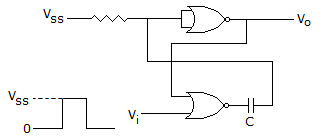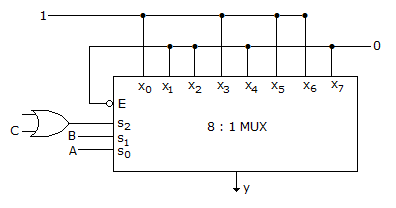Electronics and Communication Engineering - Digital Electronics
Exercise : Digital Electronics - Section 7
- Digital Electronics - Section 13
- Digital Electronics - Section 24
- Digital Electronics - Section 23
- Digital Electronics - Section 22
- Digital Electronics - Section 21
- Digital Electronics - Section 20
- Digital Electronics - Section 19
- Digital Electronics - Section 18
- Digital Electronics - Section 17
- Digital Electronics - Section 16
- Digital Electronics - Section 15
- Digital Electronics - Section 14
- Digital Electronics - Section 1
- Digital Electronics - Section 12
- Digital Electronics - Section 11
- Digital Electronics - Section 10
- Digital Electronics - Section 9
- Digital Electronics - Section 8
- Digital Electronics - Section 7
- Digital Electronics - Section 6
- Digital Electronics - Section 5
- Digital Electronics - Section 4
- Digital Electronics - Section 3
- Digital Electronics - Section 2
6.
The circuit in the figure is has two CMOS-NOR gates. This circuit functions as a


Answer: Option
Explanation:
It is simple monostable multivibrator.
7.
A 6 bit DAC uses binary weighted resistors. If MSB resistor is 20 k ohm, the value of LSB resistor is
Answer: Option
Explanation:
Resistances are R, 2R, 4R, 8R, 16R and 32R.
LSB resistance = 32R = 32 x 20 = 640 K ohm.
8.
A 6 bit dual slope A/D converter uses a reference of -6v and a 1 MHz clock. It uses a fixed count of 40 (101000). Then, what will be input, if the output register shows 100111 at the end of conversion.
Answer: Option
Explanation:

I/P voltage and reference voltage arc of opposite polarity.
9.
In the TTL circuit in the figure, S2 to S0 are select lines and X7 to X0 are input lines. S0 and X0 are LSBs. The output Y is


Answer: Option
Explanation:
The MUX is made up of TTL circuit. For TTL circuit open terminal is taken high, since S2 select line is connected to OR gate whose one terminal connected to C and the other is open (high) so OR gate output is S2 = 1 + C = 1.
S2 = 1 S1(B) S0(A) Y 1 0 0 0 1 0 1 1 1 1 0 1 1 1 1 0
Y = S0⊕S1 => A⊕B.
10.
The number of accumulators in 6800 are
Quick links
Quantitative Aptitude
Verbal (English)
Reasoning
Programming
Interview
Placement Papers